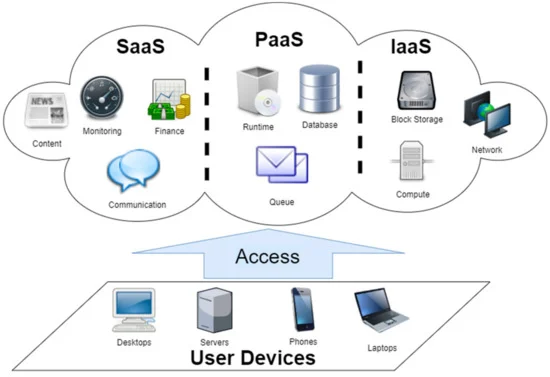

The term "Cloud Computing" is everywhere. In the simplest terms, Cloud Computing means storing and accessing data and programs over the internet instead of your computer's hard drive. Ultimately, the "Cloud" is just a metaphor for the Internet.
Cloud computing is the on-demand availability of computer system resources, especially data storage (cloud storage) and computing power, without direct active management by the user. Clouds may be limited to a single organization (enterprise clouds), or be available to many organizations (public cloud). Cloud computing relies on sharing of resources to achieve coherence and economies of scale.
Though service-oriented architecture advocates "Everything as a service" (with the acronyms EaaS or XaaS,or simply aas), cloud-computing providers offer their "services" according to different models, of which the three standard models per NIST are Infrastructure as a Service (IaaS), Platform as a Service (PaaS), and Software as a Service (SaaS). These models offer increasing abstraction; they are thus often portrayed as layers in a stack: infrastructure-, platform- and software-as-a-service, but these need not be related.
 Infrastructure as a Service (IaaS):
Infrastructure as a Service (IaaS):
"Infrastructure as a service" (IaaS) refers to online services that provide high-level APIs used to abstract various low-level details of underlying network infrastructure like physical computing resources, location, data partitioning, scaling, security, backup, etc.
Platform as a Service (PaaS):
The capability provided to the consumer is to deploy onto the cloud infrastructure consumer-created or acquired applications created using programming languages, libraries, services, and tools supported by the provider.
Software as a Service (SaaS) :
The capability provided to the consumer is to use the provider's applications running on a cloud infrastructure. The applications are accessible from various client devices through either a thin client interface, such as a web browser (e.g., web-based email), or a program interface.
 Private Cloud :
Private Cloud :
Private cloud is cloud infrastructure operated solely for a single organization, whether managed internally or by a third party, and hosted either internally or externally. Undertaking a private cloud project requires significant engagement to virtualize the business environment, and requires the organization to re-evaluate decisions about existing resources. It can improve business, but every step in the project raises security issues that must be addressed to prevent serious vulnerabilities.
Public Cloud :
A cloud is called a "public cloud" when the services are rendered over a network that is open for public use. Public cloud services may be free. Technically there may be little or no difference between public and private cloud architecture, however, security consideration may be substantially different for services (applications, storage, and other resources) that are made available by a service provider for a public audience and when communication is effected over a non-trusted network.
 Hybrid Cloud :
Hybrid Cloud :
Hybrid cloud is a composition of a public cloud and a private environment, such as a private cloud or on-premises resources, that remain distinct entities but are bound together, offering the benefits of multiple deployment models. Hybrid cloud can also mean the ability to connect collocation, managed and/or dedicated services with cloud resources.
Hybrid cloud infrastructure essentially serves to eliminate limitations inherent to the multi-access relay characteristics of private cloud networking. The advantages include enhanced runtime flexibility and adaptive memory processing unique to virtualized interface models.
Cloud computing exhibits the following key advantages:
As described above we provide the services – IaaS, PaaS, SaaS etc. – in the models of Private, Public or Hybrid Cloud Computing Services based on the requirements of the client.